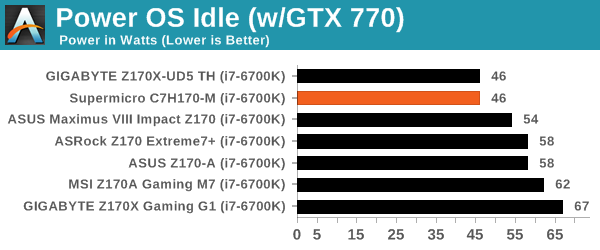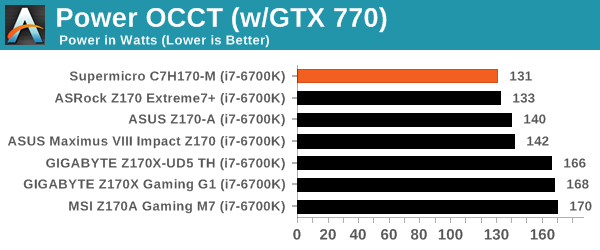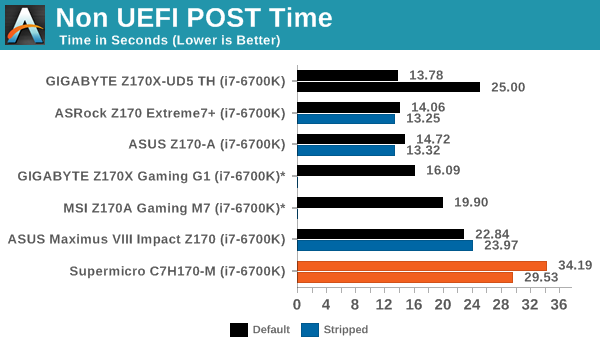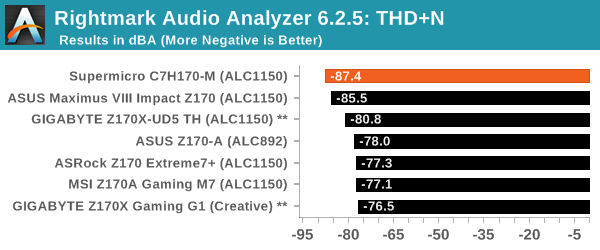Why an Overclockable Core i3 Might Not Exist: The Supermicro C7H170-M and Intel Core i3-6100TE Review
by Ian Cutress on March 17, 2016 10:30 AM EST- Posted in
- CPUs
- Intel
- Motherboards
- Core i3
- Supermicro
- Overclocking
System Performance
Not all motherboards are created equal. On the face of it, they should all perform the same and differ only in the functionality they provide - however this is not the case. The obvious pointers are power consumption, but also the ability for the manufacturer to optimize USB speed, audio quality (based on audio codec), POST time and latency. This can come down to manufacturing process and prowess, so these are tested.
Power Consumption
Power consumption was tested on the system while in a single MSI GTX 770 Lightning GPU configuration with a wall meter connected to the OCZ 1250W power supply. This power supply is Gold rated, and as I am in the UK on a 230-240 V supply, leads to ~75% efficiency > 50W, and 90%+ efficiency at 250W, suitable for both idle and multi-GPU loading. This method of power reading allows us to compare the power management of the UEFI and the board to supply components with power under load, and includes typical PSU losses due to efficiency. These are the real world values that consumers may expect from a typical system (minus the monitor) using this motherboard.
While this method for power measurement may not be ideal, and you feel these numbers are not representative due to the high wattage power supply being used (we use the same PSU to remain consistent over a series of reviews, and the fact that some boards on our test bed get tested with three or four high powered GPUs), the important point to take away is the relationship between the numbers. These boards are all under the same conditions, and thus the differences between them should be easy to spot.



The C7H170-M pulled in some good low numbers for idling and load, which should be expected for a smaller motherboard without too many controllers. The power delta from long idle to load was 86W, which is one of the best of all the 100-series systems we’ve tested.
Non UEFI POST Time
Different motherboards have different POST sequences before an operating system is initialized. A lot of this is dependent on the board itself, and POST boot time is determined by the controllers on board (and the sequence of how those extras are organized). As part of our testing, we look at the POST Boot Time using a stopwatch. This is the time from pressing the ON button on the computer to when Windows 7 starts loading. (We discount Windows loading as it is highly variable given Windows specific features.)

One drawback of systems outside of the normal big four vendors has historically been POST times, and the C7H170-M continues this trend, being over 30 seconds from power on to seeing Windows 7 being loaded. Cutting out the audio and network controllers for a stripped POST time reduced it to just under 30 seconds, but that is still twice as long as the best 100-series motherboards.
Rightmark Audio Analyzer 6.2.5
Rightmark:AA indicates how well the sound system is built and isolated from electrical interference (either internally or externally). For this test we connect the Line Out to the Line In using a short six inch 3.5mm to 3.5mm high-quality jack, turn the OS speaker volume to 100%, and run the Rightmark default test suite at 192 kHz, 24-bit. The OS is tuned to 192 kHz/24-bit input and output, and the Line-In volume is adjusted until we have the best RMAA value in the mini-pretest. We look specifically at the Dynamic Range of the audio codec used on board, as well as the Total Harmonic Distortion + Noise.


Using the ALC1150 codec means that the C7H170-M should have some potential, although the board comes without most of the enhancements we typically see with souped up versions of the codec. Perhaps surprisingly we get the best THD+N result out of any codec we’ve ever tested on 100-series motherboards.
USB Backup
For this benchmark, we transfer a set size of files from the SSD to the USB drive using DiskBench, which monitors the time taken to transfer. The files transferred are a 1.52 GB set of 2867 files across 320 folders – 95% of these files are small typical website files, and the rest (90% of the size) are small 30 second HD videos. In an update to pre-Z87 testing, we also run MaxCPU to load up one of the threads during the test which improves general performance up to 15% by causing all the internal pathways to run at full speed.
Due to the introduction of USB 3.1, as of June 2015 we are adjusting our test to use a dual mSATA USB 3.1 Type-C device which should be capable of saturating both USB 3.0 and USB 3.1 connections. We still use the same data set as before, but now use the new device. Results are shown as seconds taken to complete the data transfer.

Using the default Intel drivers, the USB 3.0 ports for the C7H170-M gave our worst result so far. This may be down to some BIOS tuning which the other motherboard manufacturers have been doing for many years.
DPC Latency
Deferred Procedure Call latency is a way in which Windows handles interrupt servicing. In order to wait for a processor to acknowledge the request, the system will queue all interrupt requests by priority. Critical interrupts will be handled as soon as possible, whereas lesser priority requests such as audio will be further down the line. If the audio device requires data, it will have to wait until the request is processed before the buffer is filled.
If the device drivers of higher priority components in a system are poorly implemented, this can cause delays in request scheduling and process time. This can lead to an empty audio buffer and characteristic audible pauses, pops and clicks. The DPC latency checker measures how much time is taken processing DPCs from driver invocation. The lower the value will result in better audio transfer at smaller buffer sizes. Results are measured in microseconds.

DPC Latency is still an odd discussion point on 100-series. We’ve seen ASUS get it right, MSI not too far behind but the others are playing catchup.










62 Comments
View All Comments
ViperV990 - Thursday, March 17, 2016 - link
The i5-6400 @ $180 seems to be a much better part to OC.nightbringer57 - Thursday, March 17, 2016 - link
Heh, when some of the younger ones today speak about overclocking, I like to remember them of how much more financially interesting overclocking used to be. It's like everyone forget how overclocking worked a few years ago. I still remember my cheap student gaming PC with a Pentium E2180 that went from 2GHz to 3GHz with a standard tower rad and only a slight voltage boost. Then you could have almost all of the performance of the 300€ CPUs (except a good bit of the cache) for 60€ or so. Multiplier overclocking is easier, yes, and it's good to reach insane peak frequencies - but this market of the "buy low, push high" overclocking has faded out (courtesy, of course, of the segmentation by core numbers as well)BrokenCrayons - Thursday, March 17, 2016 - link
Oh yeah, well I overclocked when there were still turbo buttons on the fronts of AT cases! So nyah nyah!Sarcasm aside though, drawing a line in the sand to mark when overclocking was "good" or "worthwhile" and when it stopped being fun or have any sort of point would result in an awful lot of people drawing an awful lot of lines all over the place. For instance, the last processor I bothered with overclocking was a 2GHz Pentium 4 derived Celeron. Pushing the FSB from 100 to 150MHz on an Intel boxed cooler with a little bit of extra voltage netted a 3GHz chip...which rapidly became highly unstable over the course of a few months. After that and numerous PIIs, PIIIs, the infamous Celeron 300A and whatnot, I got bored with it and my priorities shifted. I would have overclocked my VIC-20 and Trash 80 if I'd known more about computers because I couldn't resist tinkering. I think if one were to ask other people, they'd find different points in time and different processor technologies so it's probably unfair to people who are simply by nature of the date of their birth, unable to discuss overclocking in terms you're more comfortable with.
nightbringer57 - Thursday, March 17, 2016 - link
Yes, but still. There had been a more or less constant trend of tinkering around with low-end CPUs to get quasi-high-end performance out of them for quite a long time. I quote my old E2180, but over the "modern" history of computers (that is, in the current context, IBM PC and their heir), there had always been such shenanigans available to the tinkerers. If you go further in time, the trend fades as the modern concept of CPU "range" fades out and it came more down to boosting your X - generation CPU to still have a bit more oomph after most of the software environment of you given platform had moved to a new generation.And not only Intel processors, but AMD processors as well, with the pencil unlockable Durons and whatnot.
As this article states, this kind of overclocking has more or less died in recent years, partly due to technical issues (as systems get more and more complex and integrated, it becomes riskier), partly due to the current state of the market, partly due to marketing practices.
It's not about discussing overclocking in terms I personally am comfortable with or whatnot. It's just about being realistic. I hope that AMD can come back with Zen and bring a bit more freshness into the low-end overclocking market.
Spoelie - Friday, March 18, 2016 - link
Still had a lot of fun in the period between 2000-2010 with the Athlons, always buying the lowest end SKU of the performance line, and ocing between 20-40% to reach the same performance of the highest end SKU in the line.E.g.
On an nForce2 board IIRC
* Athlon XP 1800+ (Socket A Thoroughbred 256KB cache) 1533mhz OC to ~2ghz
* Athlon XP 2500+ (Socket A Barton 512KB cache) FSB166 to FSB200 = OC to "3200+"
Had a Athlon 64 2800+ on a Socket 754 for a very short time, don't remember what I did to it.
Then a "DFI LanParty UT NF4 Ultra-D" (Socket 939 w/ nForce4 & 2*512MB Winbond BH-5 PC3200 @ 250mhz 2-2-2), cream of the crop at the time.
* Athlon 64 3000+ (Venice) OC 1800 to 2250 (250bus)
* Opteron 165 (Toledo) OC 1800 to 2475 (274bus)
I loved those days
Murloc - Sunday, March 20, 2016 - link
yeah I remember a 45nm core 2 duo I had, with the boxed stock cooler I was able to lower the voltage quite a bit and daily OC it at 4GHz at the same time.It was a lucky piece compared to others.
cobrax5 - Monday, March 21, 2016 - link
I'm thinking about replacing my 45nm i7-930 @ 3.8ghz with a hex-core, 32nm Xeon and OC that to > 3.6ghz. You can get them for like under $200, and I'll keep my (admittedly aging) X58 platform.benedict - Thursday, March 17, 2016 - link
Single-threaded benchmarks show this processor to be much better than what it'd be in real life. I don't know if there are people who only run a single program at a time on their PCs. Having more cores is much more valuable than most benchmarks will show.TheinsanegamerN - Thursday, March 17, 2016 - link
I can run 7 programs at once, but if one is very demanding and is single threaded, then single threaded performance is still quite relevant. Multiple programs/=/not needing single threaded performance. Thinking that single threaded performance is not important got AMD the FX series, and subsequently a large portion of their users jumping to intel.calculagator - Thursday, March 17, 2016 - link
Everyone is different, but single threaded benchmarks give a much better picture of performance for "normal" users than multithreaded in my experience. Even if they have lots of programs running, most users are only using one program at a time. All of those open documents and web tabs use very little CPU power while they just sit there. I have about 100 active processes right now, but my CPU is idling at about 3% usage.Even a basic dual-core CPU can handle most users' multitasking. The most common exceptions are gaming and video editing, but most users are not doing those things most of the time. Consider how people use laptops so often: their CPUs have such high single-threaded/burst performance that they hardly notice how much less powerful they are than much more powerful desktop CPUs.